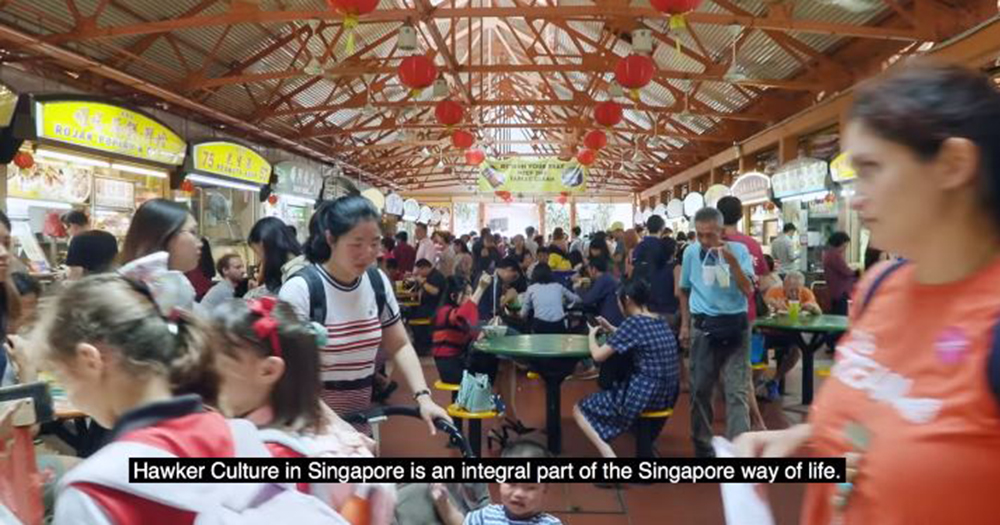It's official.
Singapore's hawker culture has been submitted for inscription on the UNESCO Representative List of the Intangible Cultural Heritage of Humanity.
Outcome to be known at the end of 2020
The submission was made on March 27, 2019, according to a joint press release by the National Heritage Board (NHB), the National Environment Agency (NEA) and The Federation of Merchants' Associations, Singapore (FMAS) -- the three organisations driving the UNESCO bid.
The joint statement on the implications of the submission said:
"The submission of the nomination is a milestone in Singapore's UNESCO inscription journey to better recognise and protect our intangible cultural heritage. A successful nomination will demonstrate to the world how proud we are of Hawker Culture in Singapore, encourage greater appreciation for our hawkers, and show our commitment as a nation to safeguard Hawker Culture for generations to come."
Should the submission be successful, Singapore's hawker culture will join 429 cultures of other countries on the list at the end of 2020.
What does UNESCO's evaluation criteria consist of?
In total, there are five criteria upon which Singapore's hawker culture will be evaluated.
These are:
- How it meets UNESCO's definition of intangible cultural heritage (seen below),
- How the potential inscription of hawker culture in Singapore increases visibility, awareness and dialogue of intangible cultural heritage,
- How existing and future safeguarding measures ensure the promotion and continued practice and transmission of the element,
- How the nomination effort has involved the widespread participation of the community, and
- The inclusion of this element in our intangible cultural heritage inventory.
Here's how UNESCO defines intangible cultural heritage:
"Cultural heritage does not end at monuments and collections of objects. It also includes traditions or living expressions inherited from our ancestors and passed on to our descendants, such as oral traditions, performing arts, social practices, rituals, festive events, knowledge and practices concerning nature and the universe or the knowledge and skills to produce traditional crafts."
So how is Singapore meeting these criteria?
1. Hawker culture as a reflection Singapore's heritage
According to the joint press release, hawker culture is a reflection of Singapore's living heritage, as it has evolved over time and been transmitted across generations.
What's more, its evolution has been in tandem with the socio-economic development of Singapore through the decades, from street hawkers, to hawker centres that have become key community spaces.
2. An increase in visibility and awareness for hawkers
Much discussion and awareness has been generated about hawkers just by the announcement of the intention to have hawker culture listed.
Singapore's hope for a successful listing is that awareness and appreciation is raised among Singaporeans on the importance of intangible cultural heritage.
A successful listing would also send a signal on the global stage that intangible cultural heritage can continue to evolve and thrive in environments that are rapidly evolving and highly urbanised.
3. Safeguarding hawker culture through multiple measures to ensure its continuity
Some specific measures that have been implemented include:
- On-the-job training and apprenticeship programmes in which hawkers pass on their culinary and stall management skills to either younger family members or apprentices,
- Culinary and training institutions that organise field trips to hawker centres for students so as cultivate awareness and outreach,
- The documenting of hawker culture in Singapore by local food advocates, community organisations and academic, and
- The key role played by FMAS in safeguarding the interests of hawkers and monitoring issues they might have, through meetings and networking sessions with the hawkers.
- This also includes FMAS' partnership with NHB and NEA in conducting focus group discussions involving hawkers, experts and stakeholders, in sharing information about the nomination and gathering feedback on safeguarding measures.
These measures have been included in the submitted nomination form.
4. Community involvement for hawker culture
Community support was one of the key factors in the nomination.
Over 31,000 messages and 850,000 pledges of support have so far been registered at the following website, oursgheritage.sg.
The website is aimed at raising awareness about Singapore's cultural heritage, with a focus on hawker culture in particular.
A social media movement, #OurHawkerCulture, is inviting Singaporeans to express support for the nomination by submitting stories and photos of hawker culture to Facebook and Instagram.
These submissions were sent to a handle @SGHawkerCulture.
It has garnered over 810,000 likes and comments thus far.
5. Including hawker culture in Singapore's own intangible cultural heritage inventory
NHB launched Singapore's own intangible cultural heritage in 2018.
Apart from hawker culture, various forms of performing arts, traditional crafts, social practices and festivals make up the local inventory.
A video explaining to UNESCO what hawker culture is about
A 10-minute video explaining what hawker culture in Singapore is about has also been made part of the submission documents to UNESCO.
The video would be for the benefit of UNESCO's Evaluation Body and the Intergovernmental Committee for the Safeguarding of the Intangible Cultural Heritage.
Here is the video:
&feature=youtu.be
Other documents consisted of:
- The official nomination form,
- letters and videos showing community support,
- a set of photographs from submissions made to the aforementioned social media movement #OurHawkerCulture
Fingers crossed.
Here's where the backlash is most likely to come from:
Top image screenshot from Heritage TV YouTube
If you like what you read, follow us on Facebook, Instagram, Twitter and Telegram to get the latest updates.
